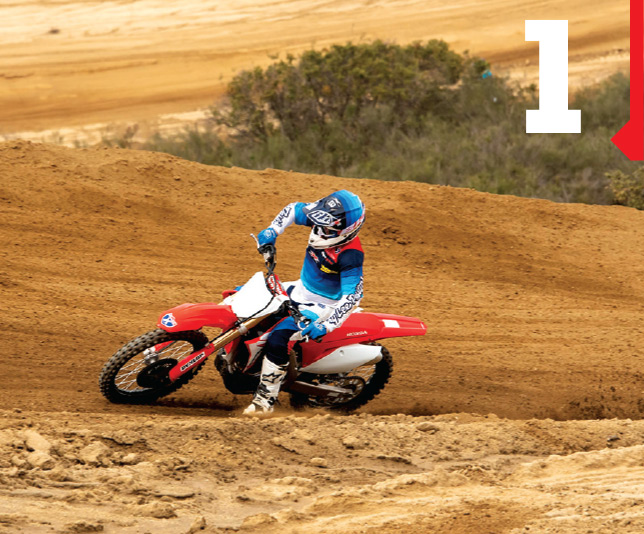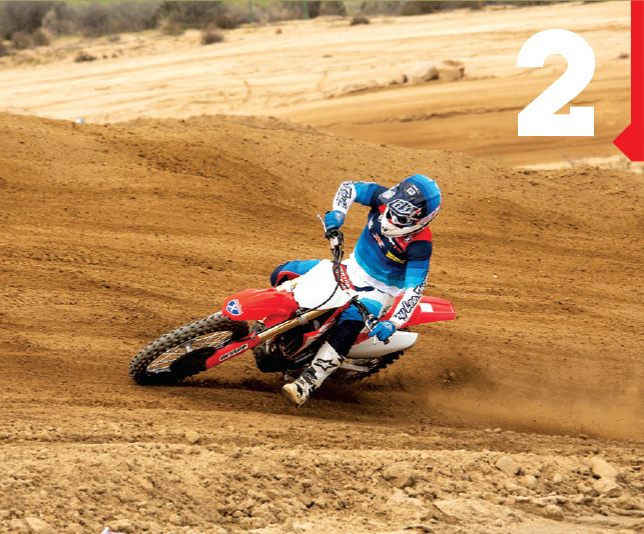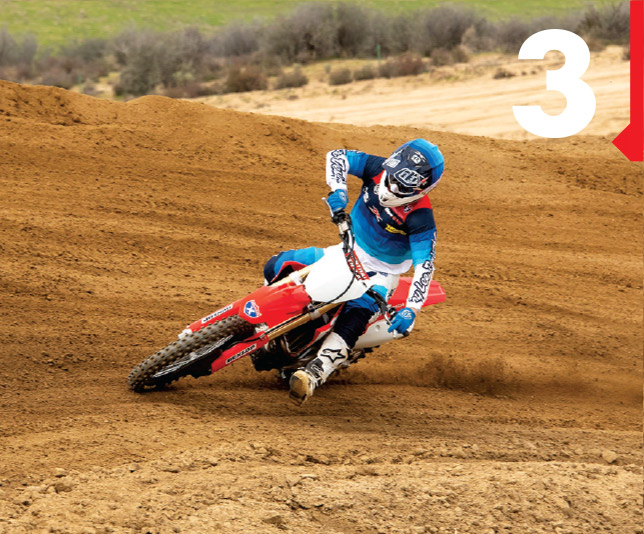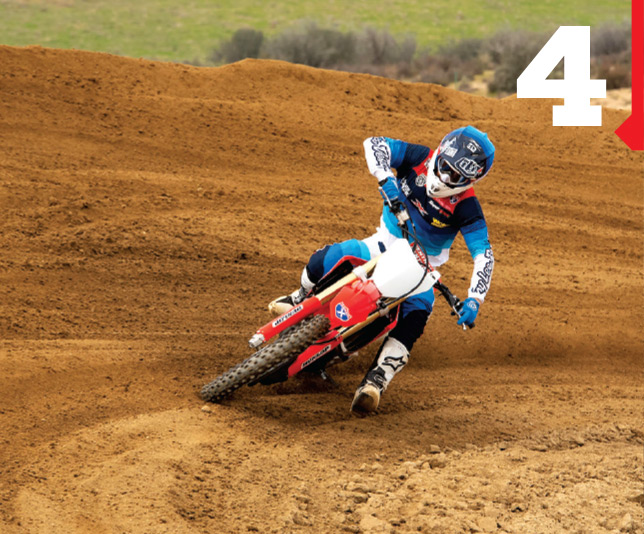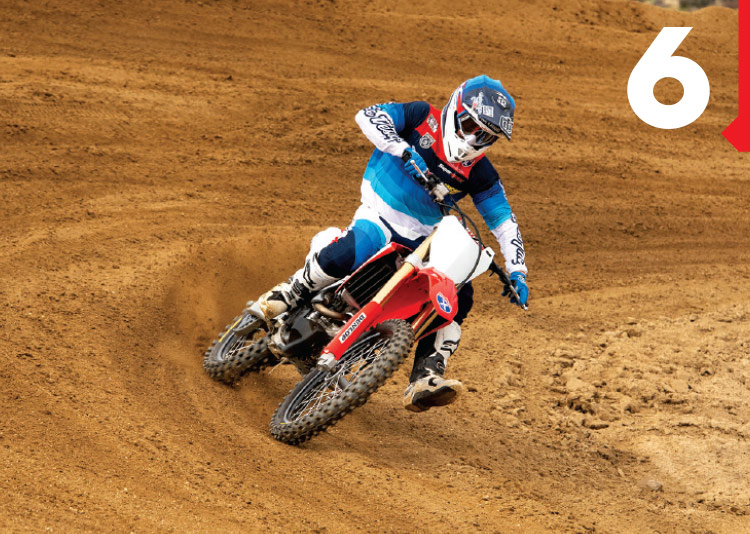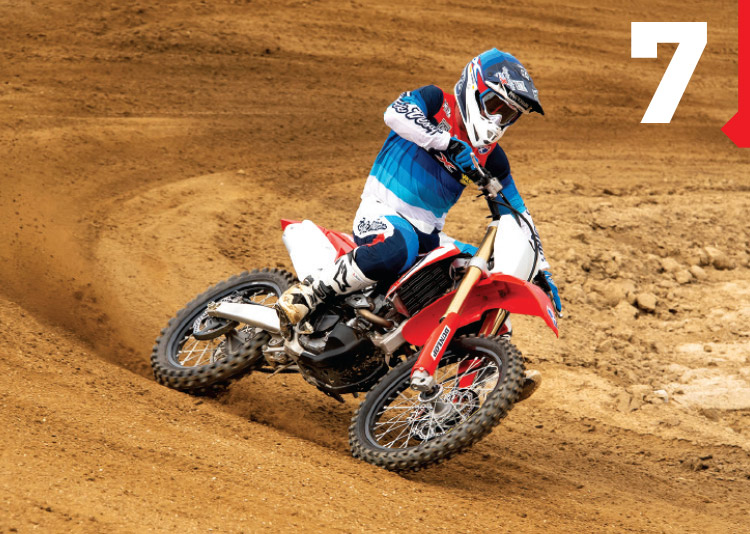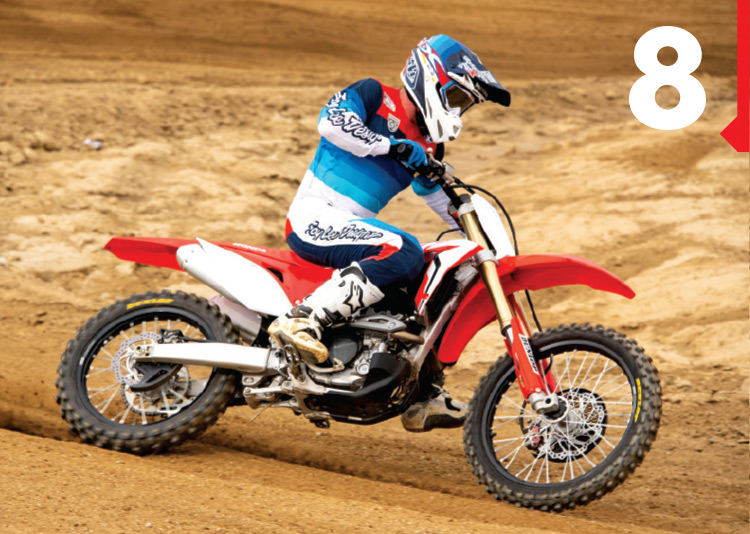


PHOTOS: SIMON CUDBY


PHOTOS: SIMON CUDBY


his month’s tip covers a couple topics that will help you navigate flat turns, as well as line selection. We’ve talked about road racing theory in motocross: opening turns up to carry more momentum. However, because of the nature of our racing surfaces, bumps and ruts ultimately determine which line is the best on any given section of the track. In this case, the outside line was bumpy, and it led to a berm that was blown out and rough. The inside line, however, was smooth and flat on the entry and all the way around the turn. In a corner like this, you have to consider how much more ground you need to cover to go to the outside versus the inside, how rough is it, and which line is faster. This particular corner was about the same speed going inside or out, but I could save so much energy by staying out of the bumps and rolling through the inside that it was the easy choice.


his month’s tip covers a couple topics that will help you navigate flat turns, as well as line selection. We’ve talked about road racing theory in motocross: opening turns up to carry more momentum. However, because of the nature of our racing surfaces, bumps and ruts ultimately determine which line is the best on any given section of the track. In this case, the outside line was bumpy, and it led to a berm that was blown out and rough. The inside line, however, was smooth and flat on the entry and all the way around the turn. In a corner like this, you have to consider how much more ground you need to cover to go to the outside versus the inside, how rough is it, and which line is faster. This particular corner was about the same speed going inside or out, but I could save so much energy by staying out of the bumps and rolling through the inside that it was the easy choice.
 This turn is a long sweeper, so you can’t really use the front brake on entry. In this case, use the gearbox to help with your braking; I dropped quickly from 4th to 2nd gear to let the engine brake slow me down in a smooth, controlled manner. This will also transfer weight to the front wheel and let it “bite” as you start to turn in.
This turn is a long sweeper, so you can’t really use the front brake on entry. In this case, use the gearbox to help with your braking; I dropped quickly from 4th to 2nd gear to let the engine brake slow me down in a smooth, controlled manner. This will also transfer weight to the front wheel and let it “bite” as you start to turn in.
 Because there are no bumps in this line, I can sit early and begin setting up for my direction change. As I start to turn the bike in and lean toward the inside, my body stays upright. You want the crack of your butt on the edge of the seat, your outside knee pressed against the radiator shroud, your left foot out and forward, and a neutral body position.
Because there are no bumps in this line, I can sit early and begin setting up for my direction change. As I start to turn the bike in and lean toward the inside, my body stays upright. You want the crack of your butt on the edge of the seat, your outside knee pressed against the radiator shroud, your left foot out and forward, and a neutral body position.
 You can’t see it here, but I’m completely off the brakes. I did some trail braking early, but you can see by the dirt coming off the rear wheel that the transmission is still providing some slowing through the engine. You want to time it so that by the time you hit the apex you’re at the right speed to begin accelerating again. If you come in too fast, you’ll drift to the outside; if you’re going too slow, you’ll be blipping the throttle as you enter and begin to round the turn.
You can’t see it here, but I’m completely off the brakes. I did some trail braking early, but you can see by the dirt coming off the rear wheel that the transmission is still providing some slowing through the engine. You want to time it so that by the time you hit the apex you’re at the right speed to begin accelerating again. If you come in too fast, you’ll drift to the outside; if you’re going too slow, you’ll be blipping the throttle as you enter and begin to round the turn.
 This turn is a long sweeper, so you can’t really use the front brake on entry. In this case, use the gearbox to help with your braking; I dropped quickly from 4th to 2nd gear to let the engine brake slow me down in a smooth, controlled manner. This will also transfer weight to the front wheel and let it “bite” as you start to turn in.
This turn is a long sweeper, so you can’t really use the front brake on entry. In this case, use the gearbox to help with your braking; I dropped quickly from 4th to 2nd gear to let the engine brake slow me down in a smooth, controlled manner. This will also transfer weight to the front wheel and let it “bite” as you start to turn in.
 Because there are no bumps in this line, I can sit early and begin setting up for my direction change. As I start to turn the bike in and lean toward the inside, my body stays upright. You want the crack of your butt on the edge of the seat, your outside knee pressed against the radiator shroud, your left foot out and forward, and a neutral body position.
Because there are no bumps in this line, I can sit early and begin setting up for my direction change. As I start to turn the bike in and lean toward the inside, my body stays upright. You want the crack of your butt on the edge of the seat, your outside knee pressed against the radiator shroud, your left foot out and forward, and a neutral body position.
 You can’t see it here, but I’m completely off the brakes. I did some trail braking early, but you can see by the dirt coming off the rear wheel that the transmission is still providing some slowing through the engine. You want to time it so that by the time you hit the apex you’re at the right speed to begin accelerating again. If you come in too fast, you’ll drift to the outside; if you’re going too slow, you’ll be blipping the throttle as you enter and begin to round the turn.
You can’t see it here, but I’m completely off the brakes. I did some trail braking early, but you can see by the dirt coming off the rear wheel that the transmission is still providing some slowing through the engine. You want to time it so that by the time you hit the apex you’re at the right speed to begin accelerating again. If you come in too fast, you’ll drift to the outside; if you’re going too slow, you’ll be blipping the throttle as you enter and begin to round the turn.
 As I reach the apex, I start applying throttle smoothly and I’m looking ahead to where I want to go and steering the front end toward the exit.
As I reach the apex, I start applying throttle smoothly and I’m looking ahead to where I want to go and steering the front end toward the exit.
 At this point in the turn I’ve made most of my direction change. A mistake many riders make is getting on the throttle too hard at this point or using the clutch to bring the rpm up; stay off the clutch, and apply as much throttle as the racing surface will allow. If the dirt is tacky, you can be aggressive; if it’s slick, you’ll need to modulate it more.
At this point in the turn I’ve made most of my direction change. A mistake many riders make is getting on the throttle too hard at this point or using the clutch to bring the rpm up; stay off the clutch, and apply as much throttle as the racing surface will allow. If the dirt is tacky, you can be aggressive; if it’s slick, you’ll need to modulate it more.
 Remember to keep your elbows up, foot forward, outside knee pressed against the bike, and look ahead while keeping your upper body quiet.
Remember to keep your elbows up, foot forward, outside knee pressed against the bike, and look ahead while keeping your upper body quiet.
 As I exit the turn, I let my foot drift back, and as I apply more throttle, I want to bring my head farther up over the triple clamps. The positioning of your upper body will also depend on the traction; the more traction you have, the more you will need to come forward to keep the front wheel down. If the track is slick, keep your upper body in a neutral position.
As I exit the turn, I let my foot drift back, and as I apply more throttle, I want to bring my head farther up over the triple clamps. The positioning of your upper body will also depend on the traction; the more traction you have, the more you will need to come forward to keep the front wheel down. If the track is slick, keep your upper body in a neutral position. ![]()
 As I reach the apex, I start applying throttle smoothly and I’m looking ahead to where I want to go and steering the front end toward the exit.
As I reach the apex, I start applying throttle smoothly and I’m looking ahead to where I want to go and steering the front end toward the exit.
 At this point in the turn I’ve made most of my direction change. A mistake many riders make is getting on the throttle too hard at this point or using the clutch to bring the rpm up; stay off the clutch, and apply as much throttle as the racing surface will allow. If the dirt is tacky, you can be aggressive; if it’s slick, you’ll need to modulate it more.
At this point in the turn I’ve made most of my direction change. A mistake many riders make is getting on the throttle too hard at this point or using the clutch to bring the rpm up; stay off the clutch, and apply as much throttle as the racing surface will allow. If the dirt is tacky, you can be aggressive; if it’s slick, you’ll need to modulate it more.
 Remember to keep your elbows up, foot forward, outside knee pressed against the bike, and look ahead while keeping your upper body quiet.
Remember to keep your elbows up, foot forward, outside knee pressed against the bike, and look ahead while keeping your upper body quiet.
 As I exit the turn, I let my foot drift back, and as I apply more throttle, I want to bring my head farther up over the triple clamps. The positioning of your upper body will also depend on the traction; the more traction you have, the more you will need to come forward to keep the front wheel down. If the track is slick, keep your upper body in a neutral position.
As I exit the turn, I let my foot drift back, and as I apply more throttle, I want to bring my head farther up over the triple clamps. The positioning of your upper body will also depend on the traction; the more traction you have, the more you will need to come forward to keep the front wheel down. If the track is slick, keep your upper body in a neutral position. ![]()
